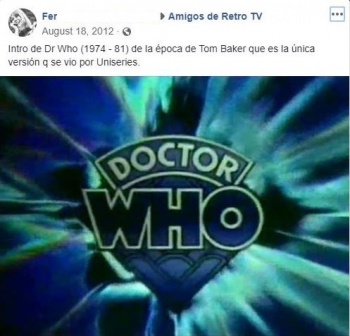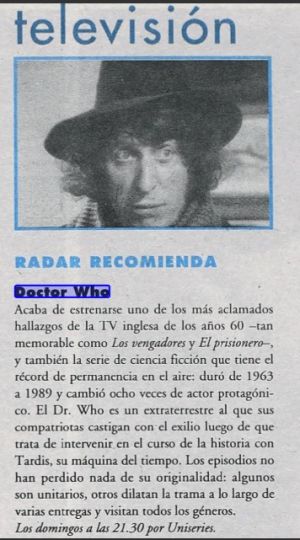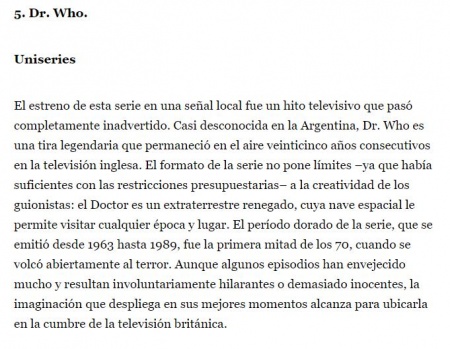Difference between revisions of "Uniseries"
Jon Preddle (talk | contribs) |
Jon Preddle (talk | contribs) |
||
| (One intermediate revision by the same user not shown) | |||
| Line 1: | Line 1: | ||
{{TOC right}} | {{TOC right}} | ||
| − | |||
'''[https://es.wikipedia.org/wiki/Uniseries UNISERIES]''' was a pay cable station, part of the [https://es.wikipedia.org/wiki/Imagen_Satelital_(empresa) Imagen Satelital] network founded in 1990. It was based in Buenos Aires, [[Argentina]]. | '''[https://es.wikipedia.org/wiki/Uniseries UNISERIES]''' was a pay cable station, part of the [https://es.wikipedia.org/wiki/Imagen_Satelital_(empresa) Imagen Satelital] network founded in 1990. It was based in Buenos Aires, [[Argentina]]. | ||
'''Imagen Satelital''' operated several specialty channels, such as '''Infinito''' (for documentaries); '''I-Sat''' (music); '''Space''' (movie) and '''Jupiter Comic''' (comedies). For classic TV drama, it launched '''Universo Series''' in February 1994.. | '''Imagen Satelital''' operated several specialty channels, such as '''Infinito''' (for documentaries); '''I-Sat''' (music); '''Space''' (movie) and '''Jupiter Comic''' (comedies). For classic TV drama, it launched '''Universo Series''' in February 1994.. | ||
| + | [[File:Uniserieslogo2000s.JPG|right|thumb|200px|Uniseries ident 1999-2003]] | ||
The channels were available on '''Cablevisión Channel 37, Multicanal 40, Telecentro 35''', '''DirectTV 125''' and cable systems in: | The channels were available on '''Cablevisión Channel 37, Multicanal 40, Telecentro 35''', '''DirectTV 125''' and cable systems in: | ||
| Line 31: | Line 31: | ||
It was announced on [https://web.archive.org/web/20011025093749/http://www.gallifreyone.com:80/news.shtml the old Outpost Gallifrey news pages in August 2001] that: "Imagen Satelital, a Latin American broadcaster, has licensed the rights to the 13th season of Doctor Who (Tom Baker's 2nd season), for Argentina, Bolivia, Chile, Paraguay and Uruguay. It could appear on the following channels after [1 October 2001]: Uniseries, Space, I. Sat, Infinito, Jupiter Comic. Good news for Latin American fans." | It was announced on [https://web.archive.org/web/20011025093749/http://www.gallifreyone.com:80/news.shtml the old Outpost Gallifrey news pages in August 2001] that: "Imagen Satelital, a Latin American broadcaster, has licensed the rights to the 13th season of Doctor Who (Tom Baker's 2nd season), for Argentina, Bolivia, Chile, Paraguay and Uruguay. It could appear on the following channels after [1 October 2001]: Uniseries, Space, I. Sat, Infinito, Jupiter Comic. Good news for Latin American fans." | ||
| − | + | It was the '''Uniseries''' channel that ultimately aired the series. | |
| + | |||
| + | Later, according to the original '''This Week in Doctor Who''' newsletters, some of the stories being shown featured Leela and K9, which indicates that the package extended beyond season 13, and included stories from season 15. But with there being three separate broadcast cycles, two of which were of odd-numbered runs, does mean that the available airdates info isn't necessarily complete. | ||
| + | |||
| − | + | '''SUBTITLED?''' | |
| − | The '''This Week''' data states that the episodes had [[Spanish]] subtitles. This would be a first, since all previous [[:Category:South America|South American]] screenings of Tom Baker stories in the late 1970s and 1980s used the copies dubbed into [[Spanish]], while the various regional stations in [[Spain]] re-dubbed the episodes they had into their own languages. | + | The '''This Week''' data states that the episodes had [[Spanish]] subtitles. This would be a first, since all previous [[:Category:South America|South American]] screenings of Tom Baker stories in the late 1970s and 1980s used the copies dubbed into Latin American [[Spanish]], while the various regional stations in [[Spain]] re-dubbed the episodes they had into their own languages. |
It is possible that the note about being subtitled is incorrect, and these were in fact dubbed episodes after all. | It is possible that the note about being subtitled is incorrect, and these were in fact dubbed episodes after all. | ||
| − | |||
| − | + | '''WHAT STORIES WERE SHOWN?''' | |
| + | [[File:DW Uniseries 9-Jun-2002.jpg|right|thumb|300px|Diario Pagina 12, 9 June 2002]] | ||
| + | |||
| + | According to this [https://twitter.com/ADCalzetta/status/502209619993702401 TWEET from August 2014], one of the stories appears to have been [[The Seeds of Doom]]. | ||
| + | |||
| + | And the "Oid Mortales" site from Argentina - [https://web.archive.org/web/20041028014421/http://www.oidmortalesdiscos.com.ar:80/oidmortales/series_tv/d.htm HERE] - lists a number of TV series on PAL VHS tape (the format used in Argentina) many of which happened to also be shown on '''Uniseries''', including '''subtitled''' copies of the following five stories / 22 episodes from Season 13 of '''Doctor Who''': | ||
| + | |||
| + | Five stories, 22 episodes: | ||
| + | |||
| + | {| {{small-table}} | ||
| + | |- | ||
| + | |4F||[[Terror of the Zygons]]||4 | ||
| + | |- | ||
| + | |4G||[[Pyramids of Mars]]||4 | ||
| + | |- | ||
| + | |4J||[[The Android Invasion]]||4 | ||
| + | |- | ||
| + | |4K||[[The Brain of Morbius]]||4 | ||
| + | |- | ||
| + | |4L||[[The Seeds of Doom]]||6 | ||
| + | |- | ||
| + | |} | ||
| + | |||
| + | Are these tapes off-air recordings from '''Uniseries'''? | ||
| + | |||
| + | But if only 22 episodes were from Season 13, to account for claims that Leela / K9 stories also played, then did '''Uniseries''' purchase an additional package of Season 15 stories? And if so, which ones? | ||
| + | |||
| + | One possibility is that '''Uniseries''' had the option on the same stories that had aired in [[Colombia]] in 1980 and 1987; this was a package of nine serials / '''38 episodes''' (a selection from season 12, 13, 14 and 15) - and as we cover below, the longest of the Uniseries runs was no less than '''35 weeks'''. | ||
| + | |||
| + | The following may have been some of the stories that screened: | ||
Nine stories, 38 episodes: | Nine stories, 38 episodes: | ||
| Line 66: | Line 97: | ||
|- | |- | ||
|} | |} | ||
| − | |||
| − | |||
Of note, the 7-year sales period on each in this batch of stories would have expired between 2002 and 2005. That the '''Uniseries''' run suddenly concluded at the end of December 2002 - possibly even mid-story - suggests that their rights to screen these stories had the end of the year as a fixed deadline. | Of note, the 7-year sales period on each in this batch of stories would have expired between 2002 and 2005. That the '''Uniseries''' run suddenly concluded at the end of December 2002 - possibly even mid-story - suggests that their rights to screen these stories had the end of the year as a fixed deadline. | ||
| Line 86: | Line 115: | ||
In the [https://twidw.doctorwhonews.net/archive.php?edition=2002-10-02%2012%3A20%3A51&fbclid=IwAR2eQZFy1Cq_ij_tnCmGhm1xkMnq6l9KF51oUrbMfLdyqjwbiS8AFw4r0kI#twid_7931 '''This Week''' bulletin published 2 October 2002], it was announced that '''Uniseries''' had been airing stories featuring Leela and K9, and that they were subtitled. (Only one story featuring those two companions was part of the [[Colombia]] package - [[The Invisible Enemy]].) | In the [https://twidw.doctorwhonews.net/archive.php?edition=2002-10-02%2012%3A20%3A51&fbclid=IwAR2eQZFy1Cq_ij_tnCmGhm1xkMnq6l9KF51oUrbMfLdyqjwbiS8AFw4r0kI#twid_7931 '''This Week''' bulletin published 2 October 2002], it was announced that '''Uniseries''' had been airing stories featuring Leela and K9, and that they were subtitled. (Only one story featuring those two companions was part of the [[Colombia]] package - [[The Invisible Enemy]].) | ||
| − | It's not known which of the three timeslots this news related to, or when that TARDIS team-up debuted. (This was ''probably'' the 9.30pm cycle, with the two other cycles | + | It's not known which of the three timeslots this news related to, or when that TARDIS team-up debuted. (This was ''probably'' the 9.30pm cycle, with the two other cycles being repeats of earlier stories.) |
[[File:UniseriesLaNacion.JPG|right|thumb|450px|"Dr Who" is number 5 of 12 programme highlights; La Nación, 1 December 2002]] | [[File:UniseriesLaNacion.JPG|right|thumb|450px|"Dr Who" is number 5 of 12 programme highlights; La Nación, 1 December 2002]] | ||
| − | The series had by this time been running for 22 weeks in the 9.30pm slot. | + | The series had by this time been running for 22 weeks in the 9.30pm slot - and as noted above, there are '''22 subtitled episodes''' on that VHS site. Is this significant? Did '''Uniseries''' screen the 22 Season 13 episodes first then, as they started to show the "new" Leela / K9 set at 9.30pm, commence its second repeat of the first 22? |
| − | The 9.30am episode was dropped after 17 weeks - '''This Week''' reporting that the '''27 October''' screening was the last. That this is an odd number either means the listings details are inaccurate (the 9.30am slot actually debuted earlier than indicated?), or the channel | + | The 9.30am episode was dropped after it would seem only 17 weeks - '''This Week''' reporting that the '''27 October''' screening was the last. That this is an odd number either means the listings details are inaccurate (the 9.30am slot actually debuted much earlier (by as many as five weeks) than indicated?), or the channel stopped the repeated story part-way through. |
The 4.30am / 9.30pm cycle continued for ten more weeks. | The 4.30am / 9.30pm cycle continued for ten more weeks. | ||
| Line 101: | Line 130: | ||
If the '''This Week''' data is complete, then '''82''' separate screenings took place across the three timeslots: '''35''' on Sunday at 9.30pm, '''17''' on Sundays at 9.30am, and '''30''' on Mondays at 4.30am. | If the '''This Week''' data is complete, then '''82''' separate screenings took place across the three timeslots: '''35''' on Sunday at 9.30pm, '''17''' on Sundays at 9.30am, and '''30''' on Mondays at 4.30am. | ||
| − | Of course as noted, '''This Week''' only reported on the start of the three timeslots after they had already commenced, so it's possible they missed a couple of weeks, so two, three or four additional episodes could be added to the start of | + | Of course as noted, '''This Week''' only reported on the start of the three timeslots after they had already commenced, so it's possible they missed a couple of weeks, so two, three or four additional episodes could be added to the start of the slots to give them all even-numbered runs. |
| − | But if only 35 episodes did air in the 9.30pm slot, then '''Uniseries''' ended | + | But if only 35 episodes did air in the 9.30pm slot, then '''Uniseries''' must have ended another story mid-way through. This would make sense if '''Uniseries''' only had the rights to screen the series until the end of 2002, and had to literally stop when they did on 29 December irrespective of whether or not they had screened all the episodes they had acquired. |
| − | + | What we potentially have here is the full run of 22 from Season 13, then only 13 episodes from the package of Leela /K9 adventures being shown at 9.30pm, and all 22 plus two season 15 4-parters in the 4.30am slot. The curtailed 9.30am slot was an incomplete run of the season 13 stories. | |
| − | + | But with there being no titles in the '''Uniseries''' guide at the time, and the lack of any conclusive historical data available online, we will '''never know exactly''' what aired on those 82 airdates… | |
Latest revision as of 03:07, 10 July 2025
UNISERIES was a pay cable station, part of the Imagen Satelital network founded in 1990. It was based in Buenos Aires, Argentina.
Imagen Satelital operated several specialty channels, such as Infinito (for documentaries); I-Sat (music); Space (movie) and Jupiter Comic (comedies). For classic TV drama, it launched Universo Series in February 1994..
The channels were available on Cablevisión Channel 37, Multicanal 40, Telecentro 35, DirectTV 125 and cable systems in:
In September 1998, Universo Series was renamed Uniseries. Four years later, Doctor Who aired on Uniseries.
The Uniseries channel was replaced by Retro on 2 March 2003. In 2007, Imagen Satelital was bought out by the Time-Warner group. Under the new management, Retro continued for two more years, and was eventually closed down in April 2009.
DOCTOR WHO ON UNISERIES
This was the first time Doctor Who was available to multiple countries in South America
BBC Records
Stories Bought and Broadcast
TOM BAKER
It was announced on the old Outpost Gallifrey news pages in August 2001 that: "Imagen Satelital, a Latin American broadcaster, has licensed the rights to the 13th season of Doctor Who (Tom Baker's 2nd season), for Argentina, Bolivia, Chile, Paraguay and Uruguay. It could appear on the following channels after [1 October 2001]: Uniseries, Space, I. Sat, Infinito, Jupiter Comic. Good news for Latin American fans."
It was the Uniseries channel that ultimately aired the series.
Later, according to the original This Week in Doctor Who newsletters, some of the stories being shown featured Leela and K9, which indicates that the package extended beyond season 13, and included stories from season 15. But with there being three separate broadcast cycles, two of which were of odd-numbered runs, does mean that the available airdates info isn't necessarily complete.
SUBTITLED?
The This Week data states that the episodes had Spanish subtitles. This would be a first, since all previous South American screenings of Tom Baker stories in the late 1970s and 1980s used the copies dubbed into Latin American Spanish, while the various regional stations in Spain re-dubbed the episodes they had into their own languages.
It is possible that the note about being subtitled is incorrect, and these were in fact dubbed episodes after all.
WHAT STORIES WERE SHOWN?
According to this TWEET from August 2014, one of the stories appears to have been The Seeds of Doom.
And the "Oid Mortales" site from Argentina - HERE - lists a number of TV series on PAL VHS tape (the format used in Argentina) many of which happened to also be shown on Uniseries, including subtitled copies of the following five stories / 22 episodes from Season 13 of Doctor Who:
Five stories, 22 episodes:
| 4F | Terror of the Zygons | 4 |
| 4G | Pyramids of Mars | 4 |
| 4J | The Android Invasion | 4 |
| 4K | The Brain of Morbius | 4 |
| 4L | The Seeds of Doom | 6 |
Are these tapes off-air recordings from Uniseries?
But if only 22 episodes were from Season 13, to account for claims that Leela / K9 stories also played, then did Uniseries purchase an additional package of Season 15 stories? And if so, which ones?
One possibility is that Uniseries had the option on the same stories that had aired in Colombia in 1980 and 1987; this was a package of nine serials / 38 episodes (a selection from season 12, 13, 14 and 15) - and as we cover below, the longest of the Uniseries runs was no less than 35 weeks.
The following may have been some of the stories that screened:
Nine stories, 38 episodes:
| 4C | The Ark in Space | 4 |
| 4B | The Sontaran Experiment | 2 |
| 4E | Genesis of the Daleks | 6 |
| 4D | Revenge of the Cybermen | 4 |
| 4G | Pyramids of Mars | 4 |
| 4L | The Seeds of Doom | 6 |
| 4R | The Robots of Death | 4 |
| 4T | The Invisible Enemy | 4 |
| 4V | Horror of Fang Rock | 4 |
Of note, the 7-year sales period on each in this batch of stories would have expired between 2002 and 2005. That the Uniseries run suddenly concluded at the end of December 2002 - possibly even mid-story - suggests that their rights to screen these stories had the end of the year as a fixed deadline.
Transmission
The first listing for Doctor Who on the Uniseries channel reported by This Week… was on Sunday, 5 May 2002 at 9:30pm, in a half-hour block.
On that date, the Argentinian online paper El Litoral had a brief introductory piece HERE, which refers to this as the "estreno" (premiere) episode.
The online newspaper La Nación also mentioned the series on 2 June 2002.
After six weeks of single screenings, a second episode was added to the schedule, commencing Monday, 10 June 2002 at 4:30am. It's not known if this was the same as the previous 9.30pm episode or the start of a fresh cycle of stories.
By July 2002, a third episode had been added to the schedule, this run screening at 9.30am on Sundays. Again, it's not known if this was the same episode as either of the other two, or the beginning of a third repeat cycle of stories. The first airdate noted for this timeslot was in the This Week bulletin covering 7 July 2002, but it's not known if this was the actual debut of the run in that slot. It's possible that slot had already been running for several weeks by then.
In the This Week bulletin published 2 October 2002, it was announced that Uniseries had been airing stories featuring Leela and K9, and that they were subtitled. (Only one story featuring those two companions was part of the Colombia package - The Invisible Enemy.)
It's not known which of the three timeslots this news related to, or when that TARDIS team-up debuted. (This was probably the 9.30pm cycle, with the two other cycles being repeats of earlier stories.)
The series had by this time been running for 22 weeks in the 9.30pm slot - and as noted above, there are 22 subtitled episodes on that VHS site. Is this significant? Did Uniseries screen the 22 Season 13 episodes first then, as they started to show the "new" Leela / K9 set at 9.30pm, commence its second repeat of the first 22?
The 9.30am episode was dropped after it would seem only 17 weeks - This Week reporting that the 27 October screening was the last. That this is an odd number either means the listings details are inaccurate (the 9.30am slot actually debuted much earlier (by as many as five weeks) than indicated?), or the channel stopped the repeated story part-way through.
The 4.30am / 9.30pm cycle continued for ten more weeks.
On 1 December 2002, La Nación included "Dr Who" at number 5 in its list of 12 programme highlights of 2002 (see clipping to the right).
The final listings found by This Week for Doctor Who on the Uniseries site was the last of the 9.30pm episodes, on Sunday, 29 December, and the last at 4.30am on Monday, 30 December 2002.
If the This Week data is complete, then 82 separate screenings took place across the three timeslots: 35 on Sunday at 9.30pm, 17 on Sundays at 9.30am, and 30 on Mondays at 4.30am.
Of course as noted, This Week only reported on the start of the three timeslots after they had already commenced, so it's possible they missed a couple of weeks, so two, three or four additional episodes could be added to the start of the slots to give them all even-numbered runs.
But if only 35 episodes did air in the 9.30pm slot, then Uniseries must have ended another story mid-way through. This would make sense if Uniseries only had the rights to screen the series until the end of 2002, and had to literally stop when they did on 29 December irrespective of whether or not they had screened all the episodes they had acquired.
What we potentially have here is the full run of 22 from Season 13, then only 13 episodes from the package of Leela /K9 adventures being shown at 9.30pm, and all 22 plus two season 15 4-parters in the 4.30am slot. The curtailed 9.30am slot was an incomplete run of the season 13 stories.
But with there being no titles in the Uniseries guide at the time, and the lack of any conclusive historical data available online, we will never know exactly what aired on those 82 airdates…
TV listings
| ← AIRDATES ...... (CLICK ICON TO GO TO TABLE SHOWING EPISODE BREAKDOWN AND AIRDATES - N/S = story title is Not Stated) |
Our summary has been extrapolated from the This Week in Doctor Who bulletins, which were themselves pulled from Uniseries online schedules (all now long gone, although some generic pages from the station's site in 2002 - without any Doctor Who content - have been captured by the WayBack Machine - see below).
The Uniseries site did not provide any story titles for the three timeslots. If stories featuring Leela and K9 were screening by as early as October 2002, this could only be if the station aired the stories out of sequence.
Media
There are several generic Uniseries bumpers and trailers on YouTube, mostly from the late 1990s, none of which feature Doctor Who:
|
|
|
|
|
|
External Links
- Uniseries logos
- Uniseries Facebook page
- List of programmes shown on Uniseries
- Uniseries blog 1
- Uniseries blog 2
- WayBack Machine 26 May 2002




